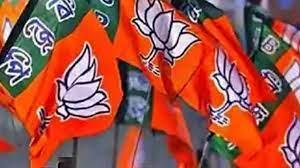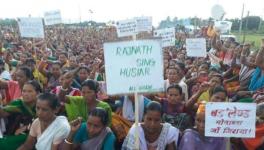Assam Elections: Why BJP Won Despite Huge Anti-Incumbency Initially

Representational Image.
A month ago, it was nearly impossible for many to think that the Bharatiya Janata Party (BJP)-led National Democratic Alliance (NDA) in Assam would retain its rule in the state, despite its poll plank and
massive rallies.
The BJP government faced huge anti-incumbency, with multiple rounds of anti-CAA (Citizenship Amendment Act) movements taking to roads, allegations of huge corruption, such as in the Arunodoi scheme for women, Assam Police sub-inspector (SI) job scam, the alleged Panchayat and Rural Development Department (P&RD) job scam. Its failure to deliver on the promises on too many fronts — including failure to provide people with permanent land deeds, closure of heavy and small industries, meeting the needs of tea tribes, and selling off airports and other industries to private players added to mistrust against the government. So, how did the BJP-led coalition, a.k.a. Mitrajot, manage to retain power for a second term?
Several questions arise, the foremost being what went wrong for the Mahajot, the grand alliance of the newly formed 10-party coalition led by the Congress party, primarily with the All India United Democratic
Front (AIUDF) and the Bodoland People's Front (BPF).
Also, the failure of new regional parties emerging out of the anti-CAA protests — such as Assam Jatiya Parishad (AJP) and Raijor Dal (RD) — with apparently Assamese nationalist sentiment as their backbone, raises another question as to whether BJP's win means a death sentence for the identity politics in Assam.
TOO MANY PARTIES IN THE FRAY
Numbers never lie. The BJP-led coalition won 75 seats in the Assam Assembly comprising 126 seats, while Congress and its allies got only 50 seats. However, beyond numbers, one thing to ponder is that there were too many parties in the fray this time — all opposing BJP.
At least three major parties were in the fray for the first time. There was AJP with All Assam Students' Union (AASU) and Asom Jatiyatabadi Yuba-Chatra Parishad (AJYCP) backing, then there was jailed peasant leader Akhil Gogoi's Raijor Dal with 70 organisations reportedly backing it, and there was eminent journalist-cum-Rajya Sabha member Ajit Bhuyan's Anchalik Gana Morcha — which was in
coalition with Congress, AIUDF, BPF and the Left parties.
Interestingly, among the parties opposing the incumbent BJP, there were two camps. While the Congress-led 10-party grand alliance appealed to the AJP and Raijor Dal many times to join the Mahajot,
both the anti-CAA parties rejected the plea saying any alliance with a national party or 'communal party’, such as AIUDF, was out of question. This led to two camps — both opposing BJP as well as opposing each other at the same time.
Eventually, AJP and RD themselves didn't stick to their own seat-sharing formula. The poll results show that on at least 13 Assembly seats, AJP or both the regional parties' combined vote share ate up either Congress' vote or BPF's. Adding these 13 seats, the Congress-led grand alliance could have secured 63 seats, not the current 50 seats.
Apart from these 13 seats, there are six more seats where AJP and RD, along with either Asom Gana Parishad (AGP) or dummy candidates fielded by the BJP, independents, or in one case, even Upendra Kushwaha's Rashtriya Lok Samata Party, a part of National Democratic Alliance now, ate up the Mahajot votes.
The state is now abuzz with the opinion that without the existence of these two parties, the Mahajot could have actually toppled the BJP-led government. However, beyond this binary of what could have happened or not, it can be safely said that too many players certainly confused the voters, the benefit of which was reaped by BJP.
IDENTITY POLITICS CLOUDED
As to the question of whether identity politics of Assam emerging out of the anti-CAA movement is at a dead end, it can be said that there are many faces of identities. Ahead of the elections, the BJP benefitted by its government giving momentary sops from the top, be it to woo the tea tribes or the six communities demanding the Scheduled Tribe (ST) status. While, at the bottom level, the Rashtriya
Swayamsevak Sangh (RSS) was at work, establishing Ekal Vidyalayas in tea gardens and char (riverine sand bed) areas, such as Majuli.
Meanwhile, Congress remained a silent spectator, with nothing but a last-minute promise to double the wages of tea tribes and kept mum on the land deeds, the floods devastating lands, or in terms of land
deeds that are directly linked to the identity politics of Assam.
The BJP also numbed the upper strata of the tribes by patronising and creating autonomous bodies, just like the Congress did in the past, thus dousing the ire of non-fulfilled aspirations of the identities. In a way, the realisation of identity could not actually take place in this round of polls.
The anti-CAA movement also failed to become an issue simply because the wave had waned by the time of the polls, following the COVID-19 crisis, which is apparently well-managed by BJP's heavy weight Health Minister Himanta Biswa Sarma. The saffron party also managed to create fractures by isolating players such as the BPF by taking the United People's Party Liberal (UPPL) in its fold in the Bodoland areas.
That's how the UPPL pegged six seats in the Assembly polls, following the formation of its coalition government in Bodoland with BJP in December 2020.
The AJP and RD tried their best to topple BJP by riding on anti-CAA sentiment, but the absence of Akhil Gogoi was felt everywhere and this had an impact on RD. While AJP did receive a section of people's
mandate, its votes failed to turn a success for the party.
BJP'S BID TO POLARISE
The BJP’s bid to polarise voters in Assam has targeted perfume baron Badruddin Ajmal’s AIUDF. It was during the run-up to the 2016 Assembly polls that the party started calling AIUDF a "Miya” party or categorically the ‘party of Bangladeshis’, mixing the Assamese infiltration phobia and religion as a tool to create an enemy of the state.
This time, Himanta Biswa Sarma began his barbs as early as in October 2020, saying that ‘35% of the population’ in the state was creating a division among the 65% on the basis of community. The state’s Muslim population is 34.22%.
After CM Sarbananda Sonowal drew criticism by referring to Muslims as “the descendants of Mughals”, Sarma continued the barbs throughout the poll campaign, by calling Muslims “descendants of Babur “and taking controversial steps such as turning madrassas into schools.
Indeed, in 2016, it was again Sarma who had begun the poll campaign for the 2016 elections by calling the polls "the last battle of Saraighat," reminding of Ahom general Lachit Borphukan's bravery against the Mughals. Giving the famous battle of Saraighat a Hindutva fabric, the BJP had introduced a new brand of Hindutva-plus-racist politics in Assam, with the bogey of Bangladeshi at its core.
While the BJP rode on its promise of development, the voters in Assam found an alternative to Congress' stagnant politics of cronyism in the party. However, after five years, as BJP failed to deliver, coupled with the anti-CAA sentiment among the Assamese, it appeared that the time had come for toppling the BJP government.
But, the new political parties took too long to be formed. During this time, BJP once again resorted to its tested formula of mixing regionalism and Hindutva — with AIUDF as an easy target. This time it was even easier for them as Congress joined forces with AIUDF.
A large chunk of the Assamese population, dissatisfied with the National Register of Citizens or NRC outcome, found respite in Sarma’s barbs against alleged Bangladeshis, which might have resulted in
upping the vote share of BJP — as the saffron party has not only been able to maintain its tally of 60 seats on its own but also has seen an increase of 3.70% of vote share. The BJP’s vote share increased from 29.51% in 2016 to 33.21% in 2021. All other parties — including Congress, AIUDF and BPF — have seen a decrease in their vote shares this time.
In terms of the politics of polarisation, however, AIUDF also has a due share. Party chief Ajmal, addressing a rally at the Gauripur constituency of Dhubri district on January 21, reportedly said: "BJP has listed 3,500 mosques across the country and will demolish all of them if they form the next government in 2024 general elections."
His remarks immediately sparked a debate, further fuelling Sarma to invoke Lord Rama at BJP's "Vijay Sankalp Samaroh" in Nalbari on January 24, to defeat Ajmal and the entire opposition.
Interestingly, while AIUDF saw a decline of 3.76% in its vote share since 2016, though it bagged 16 seats this time instead of 13 seats in the last Assembly elections.
BJP'S 'BENEFICIARY' POLITICS, ROADS AND BRIDGES
With multiple doles both from the Centre and the state, the saffron party created a new kind of vote bank in Assam. Sarma, during his tenure as the education minister in the Congress ministry, started giving away doles of laptops and continued the scheme even during his BJP tenure, where he has more power. So, he introduced a slew of schemes — ranging from giving away scooties to matriculate girls, to Arunodoi scheme for rural women, a dole of Rs 12,000 to pregnant tea tribe women, to giving away land deeds, thus creating a new set of beneficiaries, which is popularly known as the Hitadhikari politics
now.
Even though most of these schemes are under the cloud of corruption, there is a dominant perception that Sarma doled a lot. In addition to his politics of creating beneficiaries, keeping the people busy on debating who's got what, Sarma is popular among Teacher Eligibility Test (TET) teachers too. Right ahead of the polls, on February 6, Sarma gave more than 29,000 teachers regular jobs.
Further, on September 12, 2020, Sarma announced infrastructure projects worth nearly Rs 12,000 crore — ranging from building colleges to road corridors — many of which, however, remain still pending or
work in progress. These projects, whether they have been finished or not, gave the BJP an edge over the Congress-led grand alliance. Keeping works unfinished, such as a bridge from Jorhat to Majuli that
never even started, is categorically asking voters for more time or, another term.
CONGRESS’ LATE WAKE-UP CALL; AIUDF’S CANDIDATE SELECTION
The opposition Congress on the other side has been on tenterhooks with rifts within the party, and rumours doing rounds even in January this year. Over the past five years, the party divided into many fronts. All these rifts and factions kept Congress busy until recently when the party's central committee sent one of its general secretaries, Jitendra Singh, to narrow the rifts within the state committee, as
well as Chhattisgarh CM Bhupesh Baghel to leave his own state and manage Assam Congress for no less than a period of three months.
The Congress had been in a slumber before that and failed to raise alarms on a number of issues such as the closure of two units of Hindustan Paper Corporation Limited in the state, the issues pertaining to the state's poor education and healthcare system, corruption issues, or even the flood or land deed-related issues at times. In the past five years, the party failed to take a firm stand even on CAA.
Even during seat sharing, it left a few sure shots to BPF or AIUDF. For example, at the lower Assam constituency of Bijni, Jamsher Ali, an eminent journalist, was dropped for BPF candidate Kamal Singh Narzary. While Ali joined UPPL, the Mahajot lost the seat.
Many have also pointed fingers at AIUDF chief Ajmal for allegedly distributing candidature for money. This led to many of its district-level cadres to even vandalise AIUDF party offices, such as in Hailakandi. The AIUDF, however, managed to win all three Hailakandi seats.
THE THIN SHINING LINE IN BENGALI LAND BARAK VALLEY FOR MAHAJOT
For both Congress and AIUDF, the thin shining line remained the Bengali-dominated Barak valley, where both parties won more seats than 2016. The Congress bagged four seats from the 15 seats of Barak valley, while AIUDF won five seats, one more from both parties' tally from the previous Assembly. The BJP had won eight seats from the valley in 2016, while it could retain only six this time. Despite being more polarised, the BJP lost two seats in the valley because the seat-sharing formula worked in favour of the Mahajot. Raijor Dal and AGP also fielded candidates in the valley, but as both parties are primarily Assamese-dominated parties, they failed to gain ground.
The writer is an independent content management consultant based in Assam.
Get the latest reports & analysis with people's perspective on Protests, movements & deep analytical videos, discussions of the current affairs in your Telegram app. Subscribe to NewsClick's Telegram channel & get Real-Time updates on stories, as they get published on our website.
























